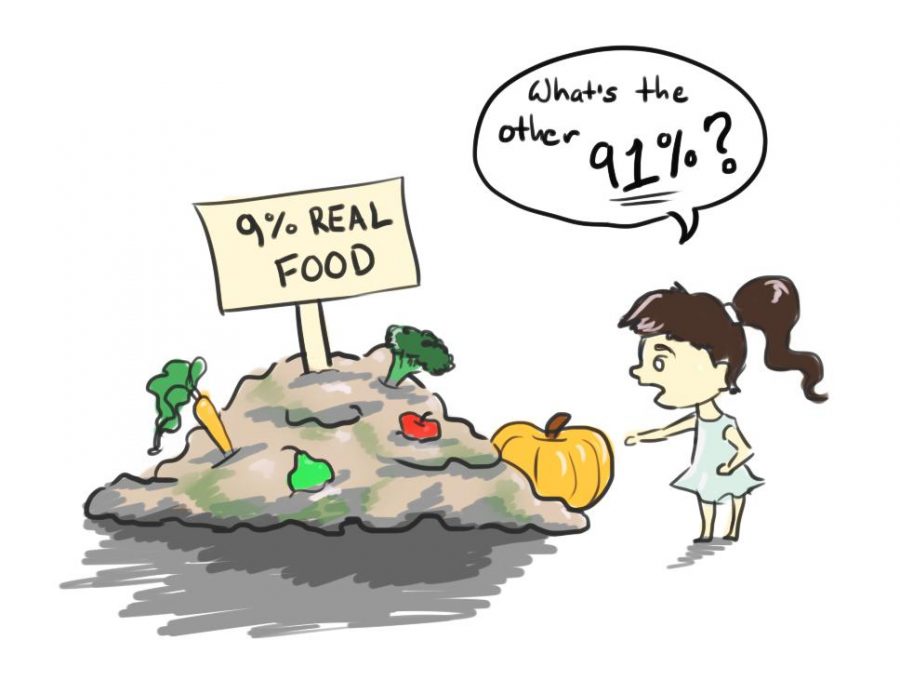At any given time, students fill our on-campus dining hall, Market Central. After swiping in, the dining hall is packed with students crowding around the omelet station, deciding between a wrap and stir fry, or hovering around to find a booth.
Many of these students couldn’t tell you what’s in the food they’re eating.
At Pitt, only 9 percent of our food on campus is “real food.” According to the national Real Food Challenge campaign’s website, real food is locally sourced or involves ecologically sound production, as well as fair treatment of animals and fair treatment of workers. There are different tiers within the category of real food — the campaign considers food that fills one or more of the above qualifications as Real Food A, and it considers food that fits only one of these categories Real Food B.
Of the 9 percent of real food we currently have on campus, only 1 percent falls under the Real Food A category.
At Pitt, real food can promote the students’ health as well as their future well-being through practices that benefit the environment.
By promoting food that is locally grown, real food encourages students to eat food that has higher nutritional value rather than food that is imported. After harvest, fruits and vegetables continue respiration, which breaks down organic materials and leads to a loss in nutritional levels of vitamins A, C, E and B.
With its higher nutritional value, real food enables students’ brains to function at a higher capacity than processed food, which helps students combat everyday problems, such as low energy and low focus.
Pitt has already made progress toward gaining more real food.
The Real Food Challenge began as a student movement at Pitt in 2014, and it is working to increase the amount of real food on campus. Last March, Pitt’s Real Food Challenge won its campaign after Chancellor Gallagher and then-Vice Chancellor Renny Clark signed a pledge outlining Pitt’s commitment to increase Pitt’s real food to 20 percent by 2020.
Pitt’s “Food Systems Working group,” a partnership between students, Sodexo and Pitt, are currently working to create a system to ensure that Pitt reaches 20 percent of real food by 2020.
“We determine how much real food Market has by researching all the purchased products and their origin and ingredients,” the group said via email.
The group does this by holding each food item to the Real Food Challenge standards.
“We determine if each item meets the specific ‘real food criteria of being either local, fair, humane or ecologically sound,’” they said. “If the item falls into at least one of these four categories and does not contain a disqualifier [genetically modified organisms, high fructose corn syrup and meat from Concentrated Animal Feeding Operations are a few examples], then it is ‘real.’”
We still have a lot of work to do, however. As was noted above, only 9 percent of our food is “real,” according to the national Real Food Challenge’s real food calculator. This lags behind the average of the other 134 universities which, like Pitt, have pledged to increase their real food.
On average, these universities, such as Brown University and UNC Chapel Hill, have 15 percent real food on campus.
Low amounts of real food may prevent students from functioning at their highest capacity, which can be detrimental to student health — not only for nutritional reasons, but for psychological reasons as well. Seeing that, better diets can improve one’s overall mood.
For instance, “poor dietary choices can lead to depression and anxiety,” wrote Gary L. Wenk, Ph.D., for Pyschology Today, as “most relevant studies indicate that an unhealthy diet is a significant risk factor for future depressive symptoms.”
An increase of real food on campus will yield consequences that will have a positive impact outside of the dining hall as well.
Working to provide more real food on campus will positively affect the University’s impact on its community and environment.
By supporting locally grown foods, the University will decrease its carbon footprint by decreasing its food miles, which represent the distance food travels from where it is made to where it is eaten.
According to the World Watch Institute, transporting food is one of the fastest growing sources of carbon emission, as the production of imported and transported food involves four times the amount of energy and emissions as that of their domestic equivalents.
The University has the potential to further reduce its carbon emissions by supporting the ethical treatment of animals by moving away from factory-farmed meat. According to the United Nations, factory farming is one of the top contributors to our planet’s more significant environmental issues, such as climate change and air pollution, as well as water scarcity and land degradation.
While moving from factory farms to more ethical forms of production does not eliminate the waste involved in producing meat, it creates a significant reduction. For example, studies show that pasture-raised beef requires only half of the fossil fuel energy used to raise factory-farmed beef.
As a university, Pitt should invest in programs that will benefit the well-being of its student body both during and after graduation — improving our diets now and the environment as we go.
It is great that our University is working to ensure that we have 20 percent real food by 2020. But let’s use this percentage as the minimum, not an end goal.
Alyssa primarily writes on social justice and political issues for The Pitt News.
Write to her at [email protected].



